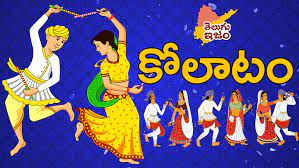Kolatam : Indeed A Popular & Traditional Team Game
Kolatam : Is indeed a traditional team game that is played with sticks. Here’s a summary of how to play Kolatam:
- Formation: Two or more people form a circle and hold sticks in both hands.
- Walking and singing: The participants walk in a circle while singing melodious choral melodies. They step in rhythm and play the sticks by sticking their sticks to the pieces of another person’s stick.
- Dance movements: As they continue walking and singing, the participants perform dance movements, connecting and separating their sticks, and dancing together with the sticks.
- Different styles: Kolatam includes different dance styles called “kopulu.” These styles can be named after legendary figures, such as Krishna or Rama, or based on the first stanza of the song or specific regions.
- Usettakam: At a certain point in the performance, there is a transition from a slower pace to a faster and more active pace called “Usethu Kovatam” or “Usettakam.” The participants become more energetic, fly, sing, and dance while stepping to the tune of the song, bringing joy to the audience.
Kolatam is performed by both men and women. It is often practiced by farmers and serves as a pastime for children after a day of hard work. The dance is also performed publicly during major festivals and Thirunals (religious processions) in Andhra Pradesh. The performances involve colorful kola sticks, anklets tied to the legs, and coordinated movements.
There are variations in how Kolatam is performed, such as women sitting on the floor and using their hands for the dance, and the use of Jadabillas (wooden braids with ropes) in some areas. The dance requires a team leader and various accessories like kolat sticks, gajjelu (anklets with bells), andels (whips), instruments, and lamps for lighting.
Discipline and obedience are important in a Kolatam team, and the team leader is responsible for maintaining order and may carry a whip to enforce discipline during the performance.
Kolatam holds significant cultural importance among the people of Andhra Pradesh, and it is often performed by groups that visit houses with devotion, offering their dance as a form of worship.
Kolatam & Rules To Follow
To play Kolatam, you will need the following:
- Team leader: The leader is responsible for guiding the team and maintaining discipline during the performance.
- Players: The participants who form the team and actively participate in the Kolatam dance.
- Garidi: It refers to the sticks used in the dance. Kolata sticks are thin at first, bulbous in the middle, and thin at the end. The ends are designed to be easy to grip.
- Luddi: This term refers to the dance movements and patterns performed with the sticks.
- Kopu: Kopu represents the various dance styles or movements within Kolatam, which may have different names and variations.
- Pochagada: Pochagada refers to the anklets worn by the participants. These anklets typically have bells that produce sound as the dancers move.
- Usethu: Usethu or usethu represents the transition from a slower pace to a faster and more active pace in the performance.
- Muktaimpu: Muktaimpu refers to the musical instruments used during the dance, such as drums or other percussion instruments.
In addition to the above, the following items are useful for Kolatam:
- Gajjelu: Anklets with bells that are worn on the legs of the participants to create rhythmic sounds.
- Andels: Whips that may be carried by the team leader to maintain discipline and correct mistakes during the performance.
- Instruments: Various musical instruments that accompany the Kolatam dance, providing rhythm and melody.
- Lamps: Lamps that provide light during the performance, enhancing the visual appeal, especially when performed at night.
The team leader is known by different names, such as Kolanna Pantula, Pennudda, Prelu Patagada, Aiyavara, or Melagada, depending on the region or tradition.
In some areas, the team leader may carry a whip over their shoulder. This whip is symbolic of authority and is used to maintain discipline and correct any mistakes made by the participants. The leader may occasionally use the whip to warn or discipline the team members.
It’s important to note that the use of whips is traditional and symbolic, and the intention is not to harm or cause pain to the participants.
Also Read : https://telugutraditions.com/wp-admin/post.php?post=1786&action=edit

